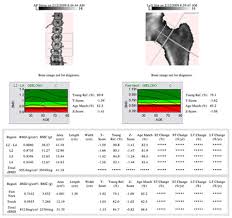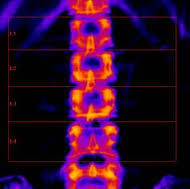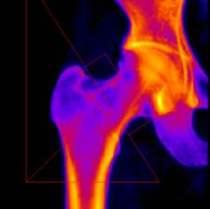DEXA (Dual Energy X-ray Absorptiometry) Scan
In the August 13, 2014 post, I discussed the second colposcopy and repeat Pap test I’d had the day before. My doctor, concerned about my ongoing vaginal discharge and previous Pap result showing abnormal glandular cells of undetermined significance (AGUS), said he might put me on an estrogen blocker if the repeat Pap also came back abnormal. But before he would prescribe a medication, he wanted me to have a DEXA (dual energy X-ray absorptiometry) scan to check my bone density. It was only after the visit that I realized I didn’t quite grasp the connection between the two. . . .
Bone Density Test & Results
I already knew from a previous DEXA scan a few years ago that I had osteopenia, or bone weakness, which is typical for a post-menopausal woman. So it was with a “just another to-do on my list” attitude that I went to my local mammography center to have a repeat bone-density scan done on August 25.
This painless, noninvasive test takes about 20 minutes or so and is nothing to be nervous about—you’re not even confined in a tube as you are with an MRI. The basic test setup for the phase 1 screening of the lumbar spine (L1–L4) requires that you drape your lower legs over a block with your knees bent and your back flat on the table, as shown in the photo below. (My scan was done using a Norland [CooperSurgical] DXA Bone Densitometer). The scanner passes over your body while you lie still, and the technologist monitors the results right next to you.
For the phase 2 screening of the top of the left thigh (left femoral neck), the under-knee support is removed, and your left leg is positioned inside a sling with your left foot turned slightly inward. (Only one thigh is scanned because it is assumed that an otherwise healthy woman will have the same results in both legs—sort of like blood pressure readings done on only one arm.)
When I was finished, the technologist printed out the preliminary (unread) results, which are based on comparisons with other women in a younger age group and also in the same age group. They looked very much like this:

An accompanying sheet explained that the results include values called the T-score (which compares your results with those of a young, healthy population) and the Z-score (which compares your results with those in an age- and gender-matched reference population). The T-score is evaluated according to criteria established by the World Health Organization (WHO):
- a score of –1 or above (0 to +4) is normal (adequate bone density)
- a score between –1 and –2.5 indicates osteopenia (reduced bone density)
- a score below –02.5 indicates osteoporosis (severely reduced bone density).
A disclaimer reads: “Although very useful, this test is not the sole determinant of bone health” and goes on to list other risk factors, such as family history, nutrition, physical activity, and others.

My results: Lumbar spine (L1–L4)—T-score = –0.96, Z-score = –0.32. Left thigh (femoral neck)—T-score = –2.02, Z-score = –0.30. “Impression: Osteopenia. Patient is at medium risk for fracture.” In other words, osteopenia, as defined by WHO, “is 10% to 25% below peak adult bone mass, or a T-score between –1.0 and –2.5 standard deviations below normal. Having a T-score between –1.0 and –2.5 is not ’pre-osteoporosis,’ but it is very important for people with low bone density to develop a good plan to prevent bone loss and osteoporosis.”

The radiologist’s report recommended weight-bearing exercises, calcium, and vitamin D supplements. My doctor’s office subsequently called and said I should be taking 1,200–1,500 mg of calcium per day and at least 800 international units (IU) of D3, although my family doctor had previously recommended 2,000 IU. (Vitamin D for bone health is usually sold as vitamin D3, or cholecalciferol, a metabolite of vitamin D that helps your bones absorb calcium; see the resources below.) The doctors did not recommend any bone-health medications at this point.
Bone Scan Results & Uterine Cancer Follow-up
While waiting for the Pap test and DEXA scan results last month, I sought out more information on estrogen blockers in case my doctor decided to prescribe one to reduce my risk of recurrent cancer following my hysterectomy and radiation treatments (vaginal brachytherapy) last winter. A quick Internet search at the time led me to assume that my doctor would most likely prescribe anastrozole (Arimidex) or tamoxifen (Nolvadex), drugs that are often used to treat breast cancer. The thought of taking a “cancer” drug didn’t appeal to me because of side (and psychological) effects; but then I was still concerned that a second Pap report might show abnormal results.
However, as discussed in the August 21, 2014 post, the follow-up Pap was normal (whew). Nevertheless, I still did a little more poking around the Internet to see what I could find out about estrogen blockers. I also wanted to understand the relationship of these drugs to bone loss after I received my DEXA scan results showing osteopenia. What I discovered was that the biochemistry of the drugs used to treat or prevent recurring cancer and those used to treat bone loss is fairly technical and confusing. At that point, I concluded that I could not be sure that my original assumption of what my doctor would probably have prescribed was correct.
Briefly, anastrozole (Arimidex), a nonsteroidal drug approved for treating breast cancer after surgery, as well as metastasis in both pre- and post-menopausal women, works by inhibiting the aromatase enzyme. This enzyme is involved in synthesizing estrogen and can therefore increase the severity of breast cancer—and, of course, uterine and other gynecologic cancers—if left unchecked. However, bone weakness has been associated with anastrozole use, and women who switched to this drug after taking tamoxifen for two years reported twice as many fractures as those who continued to take tamoxifen.
Tamoxifen (Nolvadex or a different brand), which is on WHO’s List of Essential Medicines, inhibits estrogen production in breast tissue, acting as an estrogen antagonist. In other tissues, such as the endometrium (lining of the uterus), however, it behaves as an estrogen agonist (a chemical that binds to a receptor and activates it to produce a biological response). Tamoxifen’s tissue-selective behavior directly led to the concept of selective estrogen-receptor modulators (SERMs), and by the time I read this I started getting lost in the science—especially because I no longer have a uterus. But it was still interesting to read that, unlike anastrozole, a beneficial side effect of tamoxifen is that it prevents bone loss.
Blockers, Bones, Birthdays . . . & Babes
The next time I see my doctor, which is not until November, I plan to ask him about the relationship between prescribing an estrogen blocker and getting a DEXA scan to ascertain the presence of bone loss. At the time of my last visit, he jumped from one subject—estrogen blockers—to another—DEXA scan—without explaining the connection. A number of thoughts have gone through my mind since that time, especially after doing some research. I strongly recommend that readers start with the resources listed below to learn more—and then discuss the use of estrogen blockers and/or treatments for osteopenia or osteoporosis with their doctor before making any therapeutic decisions.
In the meantime, I am taking advantage of the nice weather to do a little more walking and have increased my calcium intake as I continue to take my D3. Degenerative changes in the body are inevitable, and as I approach my 62nd birthday next week I am mindful that I need to learn to age gracefully. After all . . . after all the cancer treatments and so much else . . . the point is that I am still getting older.
This is the first birthday in years that I have not actually minded.
For more information about my uterine cancer story, click here.
Take a look at some of the people I’m keeping company with on Pinterest.
Damn right, Dame Judi .
Resources
American Bone Health – How We Diagnose Osteoporosis—Understanding the Bone Density T-score
BoneDensitomers.com – About Bone Densitometry
4BoneHealth.org – Expert Insights on Osteoporosis (Also see WHO below)
– World Health Organization – WHO Criteria for Diagnosis of Osteoporosis
LiveStrong.com – Do You Need Vitamin D3 When Taking Calcium?
– Osteoporosis Treatment: Medications Can Help
National Institutes of Health Office of Dietary Supplements – Vitamin D Fact Sheet for Consumers
National Osteoporosis Foundation – Get the Facts on Calcium and Vitamin D
UpToDate.com – Patient Education: Osteoporosis Prevention and Treatment (Beyond the Basics)
– Osteopenia – What You Need to Know
Vitamin D Council – What is vitamin D?
WebMD – Osteoporosis Health Center
–DEXA Scan (Dual X-ray Absorptiometry) to Measure Bone Health
– Picking the Right Osteoporosis Medicine for You
– Selective estrogen-receptor modulator (SERM)
– Cholecalciferol (Vitamin D3)
World Health Organization (WHO) – Model Lists of Essential Medicines (Also see 4BoneHealth.org above)






Very well done and very interesting. Thanks for the info. I have been lucky and all my tests have been good. Keep up the good work. Kisses to Mr. C. Love, Mom
LikeLike
Thanks, Mom. Love . . .
LikeLike